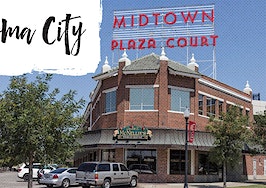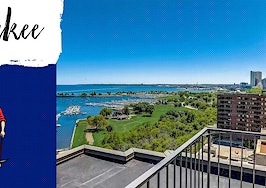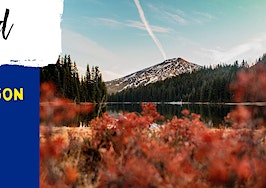This is the 11th installment in Inman’s “12 in ’21” hot neighborhoods series, which explores areas with both booming real estate markets and dense amenities. To read previous stories in the series, click here.
Over the past several years, Omaha, Nebraska, has been a mainstay on multiple up-and-coming market lists, mainly due to the city’s robust healthcare and insurance industries and housing affordability.
Although the city has received a gold star from real estate economists for its rise to the top of Midwest real estate, people’s perception of Omaha (and Nebraska as a whole) is often limited to college football, sweeping cornfields, and the occasional shoutout from former NFL all-star Peyton Manning who’d call out “Omaha” during game-winning plays.
However, those in the know, understand that Omaha is much more than a simple Midwestern town situated on the banks of the Missouri River, and there’s no neighborhood that captures the city’s pioneer past and promising future like the Blackstone District.
What is the Blackstone District?
The Blackstone District is one of Omaha’s oldest neighborhoods, sprouting up only 30 years after the city’s founding.
Blackstone, according to the neighborhood’s website, quickly became the lynchpin of Omaha’s business activity and was the it-destination for the city’s elite to live, work and play — until the stock market crash in 1929 brought the district down to its knees. Once-wealthy homeowners transformed their luxurious Victorian-style homes into boarding houses and funeral homes to survive, earning the area’s main street, Farnam Road, the unfortunate moniker of “funeral home row.”
For decades, Blackstone faded into the background until local developers began taking an interest in the area. Real estate development group Green Slate Development has been credited with kicking off the revitalization process in 2012 by transforming a building on Farnam and 40th into a home for two restaurants and a karaoke bar.
From there, the group has taken on several other projects in Blackstone, the latest being the Kimpton Cottonwood Hotel. The hotel pays homage to Blackstone’s heyday and has become a favorite spot for visitors since its opening in late 2020. “[The hotel] is the anthesis of generic,” Green Slate Development principal Jay Lund told Midwest Living of its amenities and design.
Like Inman’s other hot neighborhoods, Blackstone has not only become the place where young professionals want to unwind after a long workday but the place where they want to lay down their roots.

Erin Egan
According to the U.S. Census Bureau’s latest American Community Survey data, the average resident in Blackstone’s ZIP Code (68131), is 28 years old and pulls in a median household income of $41,845 (the median income for the city is $61,305). The district has 13,396 residents and only covers two square miles, making it one of Omaha’s most densely populated areas.
“When I’m working in that district, [my buyers] are usually millennials between 30 and 40 years old,” Mike Egan Real Estate broker Erin Egan said of the Blackstone District and the greater Midtown area. “In particular, I would say that at least 30 percent of my entire business in the past 12 months have been millennials from either Washington State, New Jersey, California and New York City.”
Although many Blackstone buyers are millennials, Egan said baby boomers are flocking to the area’s condominiums that offer easier upkeep. “Buyers in the 50 to 60 age group are looking for a place where they can be part of the hubbub and the fun without having to take care of a large house,” she said.
Blackstone District real estate
 As one of Omaha’s oldest neighborhoods, it’s no surprise that Blackstone’s residential real estate is primarily made of century-old historic craftsman and bungalow-style homes. However, like its commercial strip, Blackstone’s residential areas are experiencing an upgrade too, with a smattering of modern luxury condominiums and lofts also for sale.
As one of Omaha’s oldest neighborhoods, it’s no surprise that Blackstone’s residential real estate is primarily made of century-old historic craftsman and bungalow-style homes. However, like its commercial strip, Blackstone’s residential areas are experiencing an upgrade too, with a smattering of modern luxury condominiums and lofts also for sale.
Realtor.com, Redfin and Zillow’s September annual home price growth projections for Omaha range between 7 percent and 16.9 percent with the median sales price hovering between $230,000 and $242,000. Between the three platforms, Zillow offered the most bullish view of Omaha’s annual home price growth (+16.9 percent) and Redfin gave the city a buyer competitiveness score of 85 out of 100.
Across all three platforms, Blackstone’s residential listings are trending well above Omaha’s overall median sales price.
Redfin shows 17 available listings in Blackstone including a $440,000 121-year-old renovated single-family home, a $549,000 posh three-bedroom condominium, and a $220,000 four-bedroom bungalow. The cheapest listing is a $119,000 condominium in Park Plaza, one of Blackstone’s oldest condo communities.
Zillow shows 16 available listings in Blackstone, while Realtor.com only shows seven. However, Realtor.com was the only platform to show several newly-built luxury townhomes for $769,900 and $899,900 — the most expensive listings in Blackstone.

Brad Fricke
RE/MAX Results agent Brad Fricke said the Omaha market is moving even faster than the top real estate portals are reporting, with the Great Plains Regional MLS only showing two active listings in Blackstone and the surrounding Midtown area.
“You really have to dig for listings,” he said. “Even this fall, when we normally think it’s going to slow down, we’re still seeing areas of Omaha with multiple listings; however they’re selling very quickly.”
“My last few listings all sold within the opening weekend,” he added.
Egan said she’s noticed a similar pattern, with buyers clamoring for the chance to live in Blackstone’s condominiums and historical single-family homes. Although Blackstone is much more affordable than what you’ll find on the coasts, Egan said it’s still far from cheap.
“I think you’re at least going to expect to spend $250,000 on up,” she said. “$300,000 will get you into something that might need some work.”
“The townhomes that they’re building in certain parts of the district are starting at around $350,000,” she added. “That’s for a two-bedroom, two-bathroom. Not a large place.”
Blackstone District rental market
With the University of Nebraska medical complex nearby, Blackstone also has robust rental demand for young professionals who aren’t ready to step into homeownership just yet.
The median rent in Omaha increased 1.1 percent year over year to $855, according to Zumper’s latest estimate. Meanwhile, Zumper data shows Blackstone’s median rent is $750 — a steal compared to other parts of the city.
 Searches on Trulia, Apartment Guide, RentCafe and other rental platforms confirm Zumper’s data with plenty of Blackstone units between the $700 to $800 range. However, there’s a growing number of units in renovated historic buildings that are garnering rents in the four figures.
Searches on Trulia, Apartment Guide, RentCafe and other rental platforms confirm Zumper’s data with plenty of Blackstone units between the $700 to $800 range. However, there’s a growing number of units in renovated historic buildings that are garnering rents in the four figures.
A one-bedroom apartment at The Greenhouse, a renovated historic building on Farnam, is $962 with larger units going for as much as $1,505. The rent at St. Regis, another renovated apartment building nearby, ranges between $800 for a studio and $1,300 for a two-bathroom unit.
The Blackstone District’s newer complexes, such as Midtown Crossing Apartments, are garnering $1,015 per month for a one-bedroom unit and up to $3,200 for larger layouts.
More aggressive rent growth may be on the horizon for Blackstone and the entire Omaha metropolitan area, according to ApartmentGuide.com researcher Brian Carberry.
“Prices really are up, compared to where they were last year with all unit types, except for three-bedroom apartments,” Carberry told Omaha news outlet KMTV3 in August. “The largest increase that we saw was for a two-bedroom apartment, and that kind of follows the trend that we are seeing nationwide. There has been much more demand for larger apartment spaces during the pandemic.”
“If a lot of people are suddenly out of their homes and there is suddenly more supply on the market, it could have things go either way,” Carberry added of the impact of the pandemic and eviction moratorium laws. “Either prices could go up because some of those landlords are going to charge more to make up for the rent they weren’t able to collect.”
He concluded, “Or it’s going to cause prices to go down, if it’s going to put more supply, the demand is slightly less and it’s a little bit more of a renters market. It remains to be seen.”
Blackstone District amenities
 Although Blackstone is only two square miles, its wide array of amenities have drawn admiration from locals, visitors and some of the nation’s most popular travel and food publications.
Although Blackstone is only two square miles, its wide array of amenities have drawn admiration from locals, visitors and some of the nation’s most popular travel and food publications.
“The Blackstone District is now one of Omaha’s most sought-after neighborhoods,” Food and Drink said of the area in a lengthy 2018 feature. “As is often the case in areas that have mostly come up in the wake of the last recession, much of the appeal here is food and drink-related — the district’s central hub is a multi-block stretch of Farnam Street, absolutely packed with restaurants, bars, and cafes.”
“Not coincidentally, these are some of the most talked-up places in town right now,” it added. “[This] neighborhood right now best represents what one hopes might be Omaha of the future.”
Blackstone has 18 restaurants, including the year-old food and beer hall The Switch, 16 bars and nightlife hangouts, and 18 other spots that include hair salons, yoga studios, art galleries, hotels and several local business headquarters.
“It’s a cool area because you still get that big city luxury,” Better Homes and Gardens The Good Life Group agent Jenn Tucker said. “You’re not missing out on anything — we have everything from Broadway shows to orchestra performances and an incredible food scene.”

Jenn Tucker
“The food scene is on point. In Blackstone alone, we have some really awesome local cuisine going on,” she added. “It’s this really cool, eclectic kind of vibe of big city living, but still small-town life.”
Blackstone’s has experienced a dramatic boom in interest over the past couple of years, with the district having to double its parking to accommodate 1,400 cars.
“There are many, many small businesses and lots of eating and drinking establishments so naturally, you need [more parking] for patrons to not have to go too far to get to the location,” Blackstone Business Association President Chris Kilroy told WOWT 6 last September.
In addition to the new parking spaces, Omaha Mayor Jean Stothert’s Blackstone Business Improvement District committee has led the charge on improving the area’s walkability with the Farnam Streetscape Project. Stothert has dedicated $4.4 million to the project, which will improve traffic flow, provide more pedestrian crosswalks, wider sidewalks, and a new “signature” lighting installation for Farnam Street.
“Right now it’s functional, it’s just not usable for the volume of people wanting to come and enjoy the district,” said Blackstone Business Improvement District President Jim Farho told the Omaha World-Herald. “Our goal is to make sure residents and the community-at-large can enjoy the district and know they’re in a safe place.”
The $4.4 million will come from city and private funds, the OWH explained, with construction slated to begin in 2023. Green Slate Development principal Jay Lund said the update can’t come fast enough, as Blackstone is growing faster than he or any of the other developers who have invested in the area, expected.
Another $43.5 million 5,000-square foot mixed-use development is currently under construction, which will provide more entertainment, restaurant and living spaces in the heart of Farnam.

Lisa Ritter
The Ritter Team agent Lisa Ritter said she’s excited about Blackstone’s revitalization and the attention it’s bringing to Omaha’s rich culture.
“There is so much more culture than people recognize — we have a strong music and arts community, much stronger than I think people would recognize,” she said. “People are investing in restoring our historic areas, such as The Cottonwood Hotel, which used to be The Blackstone Hotel.”
“John and Jackie Kennedy spent their fifth wedding anniversary there and Richard Nixon announced his candidacy for the presidency there,” she added.” Omaha used to be one of the biggest cities in the nation around the turn of the 20th century because of the railroad. We just have a ton of history.”
Which area is the next hotspot?
Although all of the attention is on Blackstone, Egan, Fricke, Tucker and Ritter said there are plenty of areas that deserve just as much attention, including Dundee, Benson, Westside and Aksarben Village.
“If you went to school in Westside and you’re still living in Omaha, you probably never want to live outside of Westside — that’s the way it tends to go,” Ritter said of Westside residents’ loyalty to the area. “It’s in the middle of Omaha with some good walkability as well, although not quite as good as the Blackstone area.”
Egan said she’s especially fond of Aksarben Village, another historical neighborhood that’s experiencing a Blackstone-esque renaissance of its own.
“Aksarben is an extreme hot spot right now. I have clients [who want to live there] and we’ve been searching for several months because the houses tend to be a little bit smaller. Every once in a while you can find a listing with more space,” she said.
“There’s shops, eateries, older homes that have been some of converted into condos, and kind of that classic feel that you’re part of the city, even though you’re out in the suburbs,” she added. “Everybody’s kind of together. You get to know your neighbors. That’s why they come here.”
Fricke said the current spotlight on Omaha has allowed people to see beyond the football and farmlands and appreciate the city’s re-emergence as a giant in the Midwest.
“A lot of people, when they hear ‘Omaha, Nebraska,’ think primarily about agriculture, ranch and farm-related industries. Obviously that we’re the Cornhuskers for football,” he said with a laugh. “But if you look at what we’ve been attracting in Omaha the last few years, Google has bought 100 acres for a data center. Facebook is building a huge data center, too.”
“Amazon just built a major distribution hub in the Omaha vicinity. LinkedIn just built two buildings in the Omaha metro,” he added. “So we are not just an agriculture community. We have a lot of technology and innovation happening here.”


























